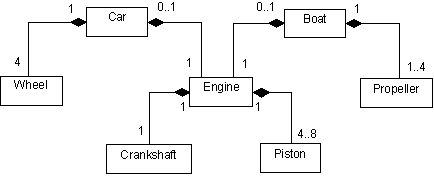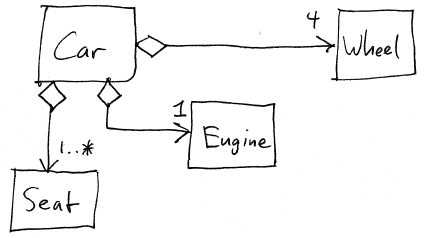Composition and Aggregation in Object-Oriented Modeling
“The past does not equal the future unless you live there.” - Tony Robbins
Understanding Composition and Aggregation in Object-Oriented Modeling
Introduction:
Object-oriented modeling is a fundamental concept in software development that allows us to represent complex systems and their relationships. When designing class diagrams, understanding the “whole-part” relationships between classes is crucial for creating a robust and efficient system. Two key types of relationships used for this purpose are Composition and Aggregation. In this blog post, we will delve into the differences between Composition and Aggregation and how they impact class relationships in object-oriented programming.
Different icons in UML Diagram
UML using a hollow diamond to show aggregation and a filled diamond to show composition.
So solid diamond indicate composition is a strong relationship, and hollow diamond indciate aggregation is a weak relationship.
Composition: The Strong “Whole-Part” Bond
Composition is a powerful relationship that signifies a strong connection between classes. In this context, the “whole” class is responsible for the creation and lifecycle of the “part” class. The “part” class is an essential component of the “whole” class and cannot exist independently outside its context. If the “whole” class is destroyed, all of its “part” objects will also be destroyed.
To illustrate this, let’s consider a real-world example. Imagine we have a class called Car, and this class has a Composition relationship with the class Engine. The Car class owns an Engine, and the Engine is an integral part of the Car. When the Car is taken out of service and dismantled, the Engine it contains will also be dismantled and scrapped. This showcases the strong bond between the “whole” and its “part.”
Composition UML Diagram
Let’s see below image

Aggregation: The Weaker “Whole-Part” Connection
Aggregation is a more relaxed relationship that indicates a weaker bond between classes. In this case, the “whole” class contains the “part” class, but the “part” class can exist independently outside the context of the “whole” class. The “part” class has a separate lifecycle and can be shared between multiple “whole” classes. If the “whole” class is destroyed, the “part” class may continue to exist.
Aggregation UML Diagram
Let’s see below image

To better understand Aggregation, let’s consider another real-world scenario. Imagine we have a class called Department, and this class has an Aggregation relationship with the class Employee. The Department class contains multiple Employee objects, but the Employee objects can also exist independently and may be part of other Department objects. If a Department is shut down or dissolved, the Employee objects may still exist if they are assigned to other departments. This highlights the weaker bond between the “whole” and its “part.”
Conclusion:
In conclusion, both Composition and Aggregation play crucial roles in object-oriented modeling, representing the “whole-part” relationship between classes. Composition signifies a strong connection, where the “whole” class takes full ownership of its “part” class, while Aggregation represents a more relaxed relationship, allowing the “part” class to exist independently outside the “whole” class. By understanding these relationships, developers can design efficient and flexible class structures, leading to well-organized and maintainable software systems.
Remember, the choice between Composition and Aggregation depends on the specific requirements of your system, and selecting the appropriate relationship will contribute significantly to the success of your software development projects. Happy coding!
–HTH–

